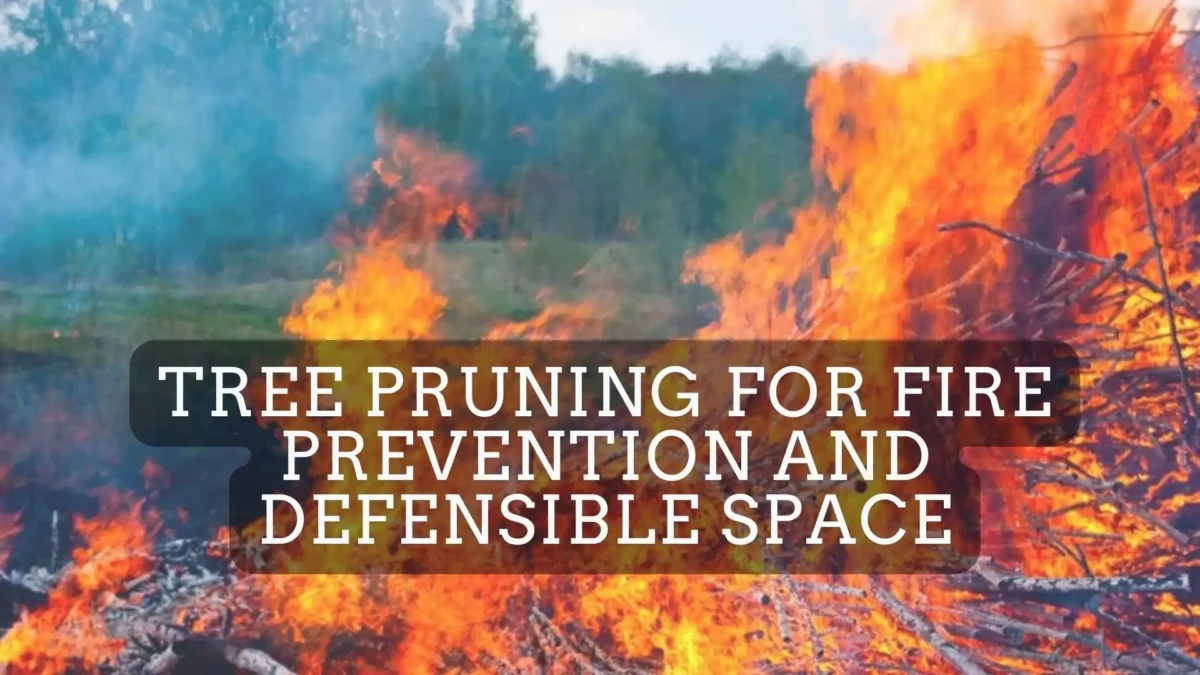
Tree Pruning for Fire Prevention and Defensible Space
Living in harmony with nature often means coexisting with fire. While fire plays a vital role in maintaining healthy ecosystems, uncontrolled wildfires pose a significant threat to homes, communities, and lives. Tree pruning is a crucial fire mitigation strategy that can significantly reduce fire risk and create a defensible space around your property.
Why Prune Trees for Fire Safety?
Wildfires can spread rapidly, fueled by dry vegetation and flammable debris. Trees, especially overgrown or unhealthy ones, can act as ladders, allowing flames to reach your house’s roof. Proper tree pruning helps in several ways:
- Reduces Fire Intensity: By removing dead, dying, or diseased branches, you eliminate potential fuel sources for a fire. This reduces the fire’s intensity and makes it easier for firefighters to control it.
- Limits Crown Fires: Pruning promotes healthy crown structures, minimizing the potential for flames to travel between treetops, creating a dangerous crown fire.
- Improves Visibility: A well-maintained tree canopy allows for better visibility for firefighters, enabling them to navigate the fire scene more effectively.
- Maintains Healthy Trees: Regular pruning encourages healthy tree growth, making them more resistant to pests and diseases that could weaken them and increase fire risk.
Creating a Defensible Space with Tree Pruning
A defensible space is a zone around your home where flammable materials are minimized, creating a barrier that slows or stops the spread of fire. Tree pruning plays a critical role in establishing this space. Here’s how:
- Horizontal Branching: Prune lower branches up to 6-10 feet from the ground to eliminate ladder fuels that allow fire to climb to your house.
- Vertical Clearance: Maintain a lean of at least 15 feet between tree branches and your house’s roof to prevent flames from directly reaching your structure.
- Crown Thinning: Selectively remove excess branches within the tree canopy to improve air circulation and reduce the overall amount of fuel available for a fire.
- Deadwood Removal: Remove dead, dying, or diseased branches as soon as possible, as these are highly flammable and can easily ignite.
Pruning Techniques for Fire Safety
Different pruning techniques are suitable for various tree species and fire safety goals. Here’s an overview of some common methods:
- Crown Cleaning: Removes dead, diseased, or broken branches from within the crown to improve overall health and reduce fire hazards.
- Crown Thinning: Selectively removes live branches to improve air circulation and reduce crown density, making the tree less susceptible to fire.
- Drop Crooning: Raises the tree crown by removing lower branches, creating clearance between the ground and the foliage.
- Deadheading: Removes spent flowers and seed pods to promote new growth and maintain a healthy appearance, while also eliminating potential fuel sources.
It’s important to note that proper pruning techniques are crucial for tree health and fire safety. Consulting with a certified arborist is highly recommended to ensure your trees are pruned correctly and minimize the risk of injury or damage.
Considerations for Tree Pruning
Before embarking on a tree pruning project, there are several factors to consider:
- Tree Species: Different tree species respond differently to pruning. Understanding the specific needs of your trees is essential for proper care.
- Tree Health: The overall health of your trees will influence the type and severity of pruning required. Diseased or stressed trees may require more extensive pruning to improve their health and fire resistance.
- Time of Year: The ideal time to prune trees varies depending on the species and location. Generally, pruning is best done during the dormant season, typically late fall to early spring, when trees are less susceptible to disease and pests.
- Local Regulations: Some municipalities may have regulations regarding tree pruning on private property. It’s advisable to check with your local authorities before starting any pruning project.
Safety Precautions When Pruning Trees
Tree pruning, especially for larger trees, can be dangerous. Here are some safety precautions to follow:
- Wear proper personal protective equipment (PPE): This includes gloves, eye protection, long pants, and sturdy shoes.
- Use sharp and well-maintained tools: Dull tools can damage trees and increase the risk of injury.
- Be aware of your surroundings: Watch out for power lines, other obstacles, and falling debris.
- Don’t attempt to prune large trees yourself: If you’re dealing with large or mature trees, it’s best.
Benefits Beyond Fire Safety
While fire mitigation is a crucial benefit, tree pruning offers additional advantages for your property and the environment:
- Improved Tree Health: Regular pruning promotes healthy tree growth, strengthens branches, and reduces the risk of disease and insect infestation. This extends the lifespan of your trees and enhances their overall aesthetics.
- Increased Sunlight Penetration: Removing excess branches allows more sunlight to reach the ground, encouraging healthy understory plant growth and promoting a more diverse ecosystem.
- Enhanced Views: Well-maintained trees with open canopies can improve the views from your property and create a more visually appealing landscape.
- Reduced Storm Damage: Pruning removes weak or dead branches that are susceptible to breaking during storms, potentially causing property damage or injury.
Additional Tips for Fire Safety Around Your Home
Tree pruning is just one aspect of creating a fire-safe defensible space. Here are some additional tips:
- Clear Brush and Debris: Remove all flammable materials like leaves, pine needles, and dead vegetation within 30 feet of your house.
- Maintain Lawns and Landscaping: Keep your lawn mowed to a height of 4 inches or less and remove flammable shrubs and plants from around your foundation.
- Create Fire Breaks: Consider creating fire breaks using gravel or low-flammable plants to act as a barrier against approaching flames.
- Maintain Proper Roof Maintenance: Clean your gutters regularly to remove debris that could ignite and ensure your roof is in good condition with fire-resistant materials.
- Develop a Fire Evacuation Plan: Have a plan in place for your family in case of a wildfire, including designated escape routes and meeting points.
Conclusions
Tree pruning for fire prevention is an essential practice for homeowners living in wildfire-prone areas. By creating a defensible space and maintaining healthy trees, you can significantly reduce your fire risk and protect your property and community. Remember, consulting with a certified arborist for proper pruning techniques and adhering to local regulations is crucial for the safety and well-being of your trees and your surroundings.



